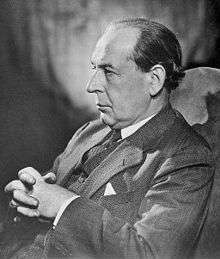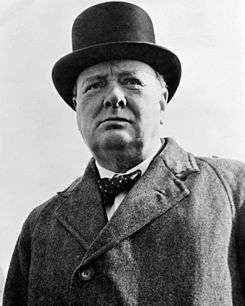John Anderson, 1st Viscount Waverley
| The Right Honourable The Viscount Waverley GCB OM GCSI GCIE PC PC FRS | |
|---|---|
 | |
| Chancellor of the Exchequer | |
|
In office 24 September 1943 – 26 July 1945 | |
| Prime Minister | Winston Churchill |
| Preceded by | Kingsley Wood |
| Succeeded by | Hugh Dalton |
| Lord President of the Council | |
|
In office 3 October 1940 – 24 September 1943 | |
| Prime Minister | Winston Churchill |
| Preceded by | Neville Chamberlain |
| Succeeded by | Clement Attlee |
| Home Secretary | |
|
In office 4 September 1939 – 3 October 1940 | |
| Prime Minister |
Neville Chamberlain Winston Churchill |
| Preceded by | Samuel Hoare |
| Succeeded by | Herbert Morrison |
| Lord Privy Seal | |
|
In office 27 October 1938 – 4 September 1939 | |
| Prime Minister | Neville Chamberlain |
| Preceded by | Herbrand Sackville |
| Succeeded by | Samuel Hoare |
| Member of Parliament for Combined Scottish Universities | |
|
In office 25 February 1938 – 23 February 1950 | |
| Preceded by | Ramsay MacDonald |
| Succeeded by | Constituency Abolished |
| Personal details | |
| Born |
8 July 1882 Eskbank, Midlothian, Scotland |
| Died |
4 January 1958 (aged 75) Lambeth, London, England |
| Political party | National |
John Anderson, 1st Viscount Waverley, GCB, OM, GCSI, GCIE, PC, PC, FRS[1] (8 July 1882 – 4 January 1958) was a British civil servant and politician who is best known for his service in the Cabinet during the Second World War, for which he was nicknamed the "Home Front Prime Minister". He served as Home Secretary, Lord President of the Council and Chancellor of the Exchequer. Anderson shelters are named after him.
Early life
He was born in Eskbank, part of Dalkeith in Midlothian and studied mathematics and geology at the University of Edinburgh and chemistry at the University of Leipzig where he wrote a thesis on the chemistry of uranium. He was a brilliant student, winning numerous prizes, but at the age of 22 he decided to forsake a career in science and sat for the British civil service examinations, coming first, while also taking a degree in economics. In later life he was elected an honorary Fellow of the Royal Society.[1]
He was appointed to the Colonial Office in 1905.
Aged only thirty-four, Anderson headed the Civil Service staff of the new Ministry of Shipping in 1917.[2] Later, he served as Under-Secretary for Ireland, and became Permanent Under-Secretary of State at the Home Office in 1922, where he had to deal with the General Strike of 1926. His career in the civil service was capped by a posting as Governor of Bengal from 1932 to 1937.
Public career
In early 1938, Anderson was elected to the House of Commons by the Scottish Universities as a National Independent Member of Parliament, a non-party supporter of the National Government. In October that year he entered Neville Chamberlain's Cabinet as Lord Privy Seal. In that capacity, he was put in charge of air raid preparations. He initiated the development of a kind of air-raid shelter named the "Anderson shelter", a small sheet metal cylinder made of prefabricated pieces which could be assembled in a garden.
War time
After the outbreak of war in 1939, Anderson returned to hold the joint portfolio of Home Secretary and Minister of Home Security, a position in which he served under Winston Churchill, often attending his War Cabinet. He retained responsibility for civil defence. In October 1940, he was replaced by Herbert Morrison in a reshuffle precipitated by Chamberlain's resignation over ill-health. He became Lord President of the Council and full member of the War Cabinet.
In 1941, he married Ava (Bodley) Wigram, widow of Ralph Wigram, a senior civil servant who had provided Winston Churchill with confidential military information during the 1930s.
In January 1945 the Prime Minister wrote to King George VI to advise that should he and his second-in-command (and heir apparent) Anthony Eden die during the war, John Anderson should become Prime Minister: 'it is the Prime Minister's duty to advise Your Majesty to send for Sir John Anderson in the event of the Prime Minister and the Foreign Secretary being killed.' Although not a member of a political party, Churchill thought Anderson had the abilities to lead the National Government, and that an independent figure was essential to the maintenance of the coalition.[3]
Following the unexpected death of Sir Kingsley Wood, the Chancellor of the Exchequer, Anderson was appointed to that office. As Chancellor, in a written Commons answer of 12 June 1945, he announced the creation of the Arts Council of Great Britain, a successor body to the Council for the Encouragement of Music and the Arts (CEMA).[4] He remained in the post until the Labour victory in the general election early in July 1945 (not announced until August).
Post-war
He left the Commons when the University constituencies were abolished at the 1950 general election. Meanwhile, he became Chairman of the Port of London authority in 1946 and Chairman of the Royal Opera House in March the same year.[5] He remained in the latter post for eleven years.
He rejected an offer to join Churchill's peacetime administration when it was formed in October 1951, and was created Viscount Waverley, of Westdean in the County of Sussex, in 1952, dying six years later at the age of 75 in St Thomas' Hospital, Lambeth, London.[6]
Styles
- 1882–1918: John Anderson
- 1918–1919: John Anderson, CB
- 1919–1920: Sir John Anderson, KCB
- 1920–1923: Sir John Anderson, KCB, PC (Ire.)
- 1923–1932: Sir John Anderson, GCB, PC (Ire.)
- 1932–1937: His Excellency Sir John Anderson, GCB, GCIE, PC (Ire.)
- 1937–1938: Sir John Anderson, GCB, GCSI, GCIE, PC (Ire.)
- 1938–1945: The Right Honourable Sir John Anderson, GCB, GCSI, GCIE, PC, PC (Ire.)
- 1945–1952: The Right Honourable Sir John Anderson, GCB, GCSI, GCIE, PC, PC (Ire.), FRS
- 1952–1956: The Right Honourable The Viscount Waverley, GCB, GCSI, GCIE, PC, PC (Ire.), FRS
- 1956–1958: The Right Honourable The Viscount Waverley, GCB, OM, GCSI, GCIE, PC, PC (Ire.), FRS
See also
References
- 1 2 Bridges, L.; Dale, H. (1958). "John Anderson, Viscount Waverley 1882-1958". Biographical Memoirs of Fellows of the Royal Society. 4: 306. doi:10.1098/rsbm.1958.0024.
- ↑ Grigg, John (2002) Lloyd George: War Leader, 1916–1918 Allen Lane, London. ISBN 0-713-99343-X. pp. 45–9
- ↑ Wheeler-Bennet, J. (1958) King George VI: His Life and Reign, pp. 544–46.
- ↑ Hansard, HC Debate 12 June 1945
- ↑ Lebrecht, Norman (2000) Covent Garden: the Untold Story: Dispatches From the English Culture War, 1945–2000, London: Simon & Schuster, pp. 80–81
- ↑ "Index entry". FreeBMD. ONS. Retrieved 12 May 2016.
Further reading
- John Anderson, Viscount Waverley, 1962 by John Wheeler-Bennett Publisher: NY, St. Martin, 1962. 445 pp., illus. ASIN: B000UDUU48
External links
| Wikimedia Commons has media related to John Anderson, 1st Viscount Waverley. |
- Hansard 1803–2005: contributions in Parliament by John Anderson
- "Archival material relating to John Anderson, 1st Viscount Waverley". UK National Archives.
.svg.png)
